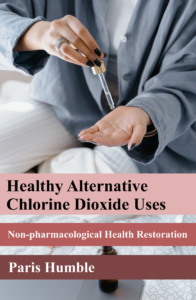Imagine this: a microscopic janitor, quietly sweeping through the corridors of your body, dissolving the clutter of toxins, pathogens, and industrial debris that your cells have been burdened with for years. This is how some proponents describe chlorine dioxide (ClO₂), not as a cure-all, but as a molecular cleanup crew, restoring balance so that your body can return to what it already knows how to do: heal itself.
Why Oxygen Matters More Than We Realize
Modern medicine has long recognized the value of oxygen. When a patient’s system is compromised, doctors rush to restore oxygen flow. Hyperbaric oxygen chambers—sealed spaces that flood the body with pressurized oxygen—are used to accelerate healing, combat infections, and regenerate tissues. Yet access to this therapy is reserved for the few who can afford it: machines costing $20,000 to $100,000, with yearly treatments running into the thousands.
Contrast that with chlorine dioxide, a simple compound that costs mere pennies per dose. Some users describe it as “portable oxygen”—a liquid you drink, which, through its oxidizing action, generates reactive oxygen species in the bloodstream. Instead of lying in a high-tech chamber, you’re fueling an inner oxygenation process, quietly unfolding on a molecular level, without the hefty price tag.
But how could something so simple rival the effects of a hyperbaric chamber?
The key lies in understanding the true villain of modern health decline: toxins.
Clearing the Biological “Traffic Jam”
Your body is designed with a brilliant blueprint. Every system—from digestion to immunity, hormone regulation to cellular repair—operates like an orchestra tuned to perfection. You don’t consciously tell your pancreas to secrete insulin or your lymph nodes to filter waste. These systems run automatically.
But modern life introduces thousands of foreign compounds your ancestors never encountered. Glyphosate from herbicides. Heavy metals like lead, mercury, and cadmium. Synthetic hormones. Plasticizers. These intruders accumulate over time, muddying the body’s communication channels and clogging the self-cleaning mechanisms that once worked flawlessly.
When toxins reach a tipping point, the body’s innate intelligence falters. Systems that once worked in harmony start working against each other. Imagine a well-rehearsed orchestra suddenly playing from different sheet music. Chaos ensues.
Chlorine dioxide, proponents argue, acts like a molecular “reset button.” Its oxidizing action selectively targets pathogens and harmful compounds without harming healthy cells. Research in water purification shows that ClO₂ breaks down glyphosate residues, neutralizes bacteria, and deactivates viral particles. The intriguing question is: if it can clean a contaminated water supply, what might it do inside a polluted biological system?

Beyond Pathogen-Killing: A Detoxification Partner?
Emerging theories suggest that chlorine dioxide may have a chelating effect on certain heavy metals, binding to them and facilitating their elimination. While this is not widely studied in human medicine, its chemical properties in environmental cleanup hint at a broader detox potential.
This perspective reframes chlorine dioxide not as a direct healer, but as a facilitator, removing barriers so the body’s natural healing intelligence can reassert itself.
In this view, disease is not merely an invasion but a reflection of a burdened system. By removing the “molecular clutter,” the body can return to its original state of self-regulation.
Rethinking “Oxygen Therapy”
Most people equate oxygen therapy with external interventions—tubes, tanks, pressurized chambers. But what if oxygenation could also be stimulated from within, through strategic oxidation that dismantles harmful compounds and frees up cellular machinery?
This idea challenges the monopoly of high-cost interventions. Instead of relying solely on external machines, we consider how internal biochemical pathways might be reactivated, using simple chemistry.
It’s not about flooding the body with oxygen indiscriminately, but about targeted oxidation—just enough to break molecular logjams without collateral damage.
A Word of Caution (and Curiosity)
Mainstream medicine warns against internal use of chlorine dioxide, citing risks of irritation, nausea, or worse at high doses. These warnings should not be dismissed lightly. Any oxidizing agent, misused or overused, carries potential harm.
But the broader conversation invites us to ask: Why does the body respond positively, anecdotally, in so many cases? Could low-dose, carefully managed oxidation play a role in rebalancing biological systems?
Science, as it stands, has not fully answered these questions. Research lags behind anecdotal reports. Regulatory bodies focus on worst-case scenarios rather than exploring therapeutic thresholds.
The conversation around chlorine dioxide is polarized, but it also reflects a deeper tension in healthcare: between high-cost, institutionally approved interventions, and low-cost, DIY approaches that leverage the body’s own capabilities.

The Janitor vs. the Engineer
Perhaps chlorine dioxide is not the “engineer” that rebuilds a broken system, but the janitor that clears the debris so the engineer (your body’s innate intelligence) can get back to work. It doesn’t create health; it removes the obstacles to health.
And sometimes, the simplest interventions—those that cost pennies instead of thousands—are the ones most overlooked.
As the debate around chlorine dioxide continues, one truth remains: your body is already brilliantly designed. Whether through hyperbaric chambers or molecular janitors, its ultimate healing power comes not from what we add, but from what we remove.
Until research provides definitive answers, the question remains open. But curiosity, as always, is a worthy guide.


Leave a Reply